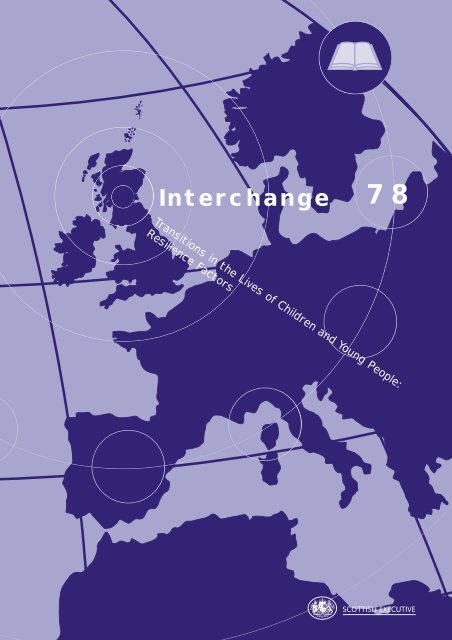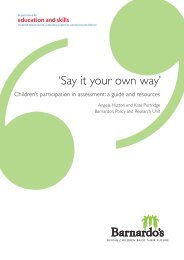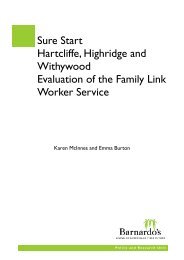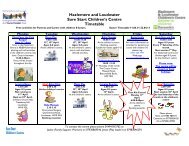Download the full report for free (PDF) - Barnardo's
Download the full report for free (PDF) - Barnardo's
Download the full report for free (PDF) - Barnardo's
Create successful ePaper yourself
Turn your PDF publications into a flip-book with our unique Google optimized e-Paper software.
Interchange<br />
Transitions in <strong>the</strong> Lives of Children and Young People:<br />
Resilience Factors<br />
78<br />
SCOTTISH EXECUTIVE
Why Interchange?<br />
Research cannot make <strong>the</strong> decisions <strong>for</strong> policy makers and o<strong>the</strong>rs concerned<br />
with improving <strong>the</strong> quality of education and services <strong>for</strong> children. Nor<br />
can it by itself bring about change. However, it can create a better basis <strong>for</strong><br />
decisions, by providing in<strong>for</strong>mation and explanation about policy and practice<br />
and by clarifying and challenging ideas and assumptions.<br />
It is important that every opportunity should be taken to communicate research<br />
findings, both inside and outside <strong>the</strong> Scottish Executive Education Department<br />
(SEED). Moreover, if research is to have <strong>the</strong> greatest possible impact on<br />
policy and practice, <strong>the</strong> findings need to be presented in an accessible,<br />
interesting and attractive <strong>for</strong>m.<br />
Interchange aims to fur<strong>the</strong>r improve <strong>the</strong> Education and Young People<br />
Research Unit’s dissemination of <strong>the</strong> findings of research funded by SEED.<br />
We hope you will find that Interchange is long enough to give <strong>the</strong> flavour of<br />
<strong>the</strong> complexities, subtleties and limitations of a research study but concise<br />
enough to give a good feeling <strong>for</strong> <strong>the</strong> findings and in some cases to encourage<br />
you to obtain <strong>the</strong> <strong>full</strong> <strong>report</strong>.<br />
The views expressed in this Interchange are those of <strong>the</strong> author(s) and do not<br />
necessarily reflect those of <strong>the</strong> Scottish Executive or any o<strong>the</strong>r organisation(s)<br />
by whom <strong>the</strong> author(s) is/are employed.<br />
Copyright © October 2002, Scottish Executive Education Department<br />
ISSN 0969-613X<br />
Interchange may be photocopied <strong>for</strong> use within your own institution.<br />
A limited number of additional copies can be obtained by writing to <strong>the</strong><br />
Education and Young People Research Unit Dissemination Officer at<br />
<strong>the</strong> Scottish Executive Education Department, Victoria Quay, Edinburgh<br />
EH6 6QQ. File copies <strong>for</strong> electronic downloading are available on <strong>the</strong><br />
Scottish Executive server at http://www.scotland.gov.uk/insight/
Transitions in <strong>the</strong> Lives of Children and Young<br />
People: Resilience Factors<br />
Tony Newman and Sarah Blackburn (Barnardo’s Policy,<br />
Research and Influencing Unit)<br />
Introduction<br />
This <strong>report</strong> describes effective strategies, in <strong>the</strong> fields of health, education and<br />
social work, <strong>for</strong> helping children cope with periods of transition and change<br />
through <strong>the</strong> promotion of resilience. The <strong>report</strong> draws on an extensive review<br />
of <strong>the</strong> international literature on <strong>the</strong> promotion of resilience. In examining<br />
<strong>the</strong> literature, <strong>the</strong> authors have taken a broad view of children’s “transitions”,<br />
taking this to mean any episode where children are having to cope with<br />
potentially challenging episodes of change, including progressing from one<br />
developmental stage to ano<strong>the</strong>r, changing schools, entering or leaving <strong>the</strong><br />
care system, loss, bereavement, parental incapacity or entry to adulthood.<br />
What is resilience?<br />
The concept appears to be understood cross-culturally as <strong>the</strong> capacity to<br />
resist or “bounce back” from adversities. A well-known clinical definition<br />
of resilience is ‘<strong>the</strong> maintenance of competent functioning despite an<br />
interfering emotionality’. A resilient child is one who exhibits positive<br />
adaptation in circumstances where one might expect, due to atypical levels<br />
of stress, a significant degradation in coping skills to take place. The<br />
International Resilience Project, which collected data from 30 countries,<br />
described resilience as ‘a universal capacity which allows a person, group<br />
or community to prevent, minimize or overcome <strong>the</strong> damaging effects of<br />
adversity’. Every country that supplied data drew on a similar range of<br />
factors, indicating that resilience, as a concept, crosses national and cultural<br />
boundaries. As this <strong>report</strong> required a common understanding of resilience in<br />
non-clinical language, <strong>the</strong> authors used <strong>the</strong> following <strong>for</strong>mulation to define<br />
and describe resilience:<br />
Resilient children are better equipped to resist stress and<br />
adversity, cope with change and uncertainty, and to recover<br />
faster and more completely from traumatic events or<br />
episodes.<br />
The concept of resilience has been subjected to a number of criticisms in<br />
recent years, notably by those who argue that it differs little from strategies<br />
aimed at achieving normal childhood adjustment. In order to find practical<br />
applications <strong>for</strong> resilience <strong>the</strong>ory, it must be subject to promotion or<br />
diminution by human agency. In o<strong>the</strong>r words, our actions, <strong>for</strong> better or worse,<br />
must be able to affect <strong>the</strong> way in which children cope with adversities during<br />
periods of transition. Simply noting child, family or environmental issues that<br />
appear associated with resilience, but are not sensitive to manipulation, may<br />
1<br />
The factors that<br />
promote resilience are<br />
widely understood.<br />
However, <strong>the</strong>re is less<br />
consensus on how we<br />
can move from <strong>the</strong>ory<br />
to practice. Are <strong>the</strong>re<br />
effective strategies<br />
that can be used and<br />
replicated in real life<br />
settings?
2<br />
Has our preoccupation<br />
with identifying risk<br />
factors reached a stage<br />
where it may be<br />
causing more harm<br />
than good? Is it<br />
possible to achieve a<br />
better balance between<br />
protecting children<br />
from risks and<br />
providing <strong>the</strong>m with<br />
developmental<br />
opportunities?<br />
Interchange 78<br />
Transitions in <strong>the</strong> Lives of Children and Young People: Resilience Factors<br />
be of <strong>the</strong>oretical interest but will have limited utility <strong>for</strong> health, education and<br />
social care services, and indeed <strong>the</strong> lay public. The authors <strong>the</strong>re<strong>for</strong>e sought<br />
to focus on strategies which have some promise <strong>for</strong> practical application.<br />
The <strong>report</strong> discusses interventions that fall within <strong>the</strong> immediate jurisdiction<br />
of education, health and social welfare agencies, ra<strong>the</strong>r than at <strong>the</strong> broader<br />
social policy level. However, in almost every dimension that is discussed,<br />
poverty and inequality are relevant, and sometimes paramount, factors. Better<br />
educational and health outcomes are more likely to result <strong>for</strong> children when<br />
<strong>the</strong>y and <strong>the</strong> families in which <strong>the</strong>y live have an income above <strong>the</strong> poverty<br />
line. All of <strong>the</strong> strategies described in this <strong>report</strong> will prove more effective<br />
in a social environment committed to <strong>the</strong> narrowing of health inequalities.<br />
General Principles of Resilience<br />
While <strong>the</strong> study of resilience has been well developed in psychology, it is<br />
less familiar in <strong>the</strong> fields of education and social care. None<strong>the</strong>less, resilience<br />
has been recently discussed in social work, education and allied journals in<br />
relation to sexual abuse; child maltreatment; <strong>the</strong> children of alcoholics;<br />
parenting and child care; child placement and children in need generally;<br />
children with emotional and behavioural difficulties; looked after children;<br />
family <strong>the</strong>rapy; personal development in schools; adoption; and, more<br />
generally, as a conceptual framework <strong>for</strong> social work practice. Why and how<br />
can <strong>the</strong> promotion of resilience help children and young people cope with <strong>the</strong><br />
adversities that arise during periods of change and transition?<br />
Our growing concern with risk<br />
Compared to earlier generations, children appear to have become less able to<br />
cope with and overcome stressors and obstacles, partly because of <strong>the</strong>ir being<br />
sheltered from challenging opportunities. Recent trends in health and social<br />
care services have tended to emphasise factors that pose risks <strong>for</strong> children,<br />
ra<strong>the</strong>r than opportunities <strong>for</strong> growth and adaptation.<br />
While our growing pre-occupation with <strong>the</strong> identification of potential risk<br />
factors has led to substantial improvements in many important aspects<br />
of children’s physical health, it has not, un<strong>for</strong>tunately, led to a similar<br />
improvement in many dimensions of children’s psychosocial well-being.<br />
On <strong>the</strong> contrary, <strong>the</strong>re is a widespread consensus that a substantial increase<br />
in psychological and conduct disorders of children has taken place in most<br />
developed countries over <strong>the</strong> past half century, a trend present even in<br />
countries with such highly admired social welfare systems as Sweden.<br />
Children <strong>the</strong>mselves have also <strong>report</strong>ed increases in long term illnesses.<br />
We are thus confronted with <strong>the</strong> worrying situation of children being affected<br />
by an absolute increase in many serious problem areas, notably conduct,<br />
attention and eating disorders, self-injurious behaviours, para-suicides and<br />
suicide itself, accompanied by an apparent weakening of a capacity <strong>for</strong> natural<br />
resistance. The promotion of resilience may be an important strategy in<br />
attempting to reverse this trend, through placing less emphasis on risk factors,<br />
and more on factors that promote well-being.
Risk and resilience<br />
Risk factors heighten <strong>the</strong> probability that children will experience poor<br />
outcomes. Resilience factors increase <strong>the</strong> likelihood that children will resist or<br />
recover from exposure to adversities. Positive child development is not simply<br />
a matter of reducing or eliminating risk factors and promoting resilience. The<br />
successful management of risk is a powerful resilience-promoting factor in<br />
itself. However, risk factors are cumulative. Children may often be able to<br />
overcome and even learn from single or moderate risks, but when risk factors<br />
accumulate, children’s capacity to survive rapidly diminishes. Transitional<br />
periods are also periods of heightened risk, illustrated, <strong>for</strong> example, by <strong>the</strong><br />
frequent decline in academic per<strong>for</strong>mance of vulnerable children on transfer<br />
from junior to senior schools. Resilience factors operate in three dimensions:<br />
<strong>the</strong> individual, <strong>the</strong> family and <strong>the</strong> external environment.<br />
Resilience factors<br />
The Child The Family The Environment<br />
Temperament<br />
(active, good-natured)<br />
Warm supportive parents Supportive extended family<br />
Female prior to and male Good parent-child Successful school experiences<br />
during adolescence relationships<br />
Age (being younger) Parental harmony Friendship networks<br />
Higher IQ Valued social role Valued social role (eg a job,<br />
(eg care of siblings) volunteering, helping neighbours)<br />
Social skills Close relationship with Close relationship with unrelated<br />
one parent mentor<br />
Personal awareness<br />
Feelings of empathy<br />
Internal locus of control<br />
Humour<br />
Attractiveness<br />
Member of religious or faith<br />
community<br />
As can be seen, some of <strong>the</strong>se factors are partly bio-genetic and <strong>the</strong>ir<br />
sensitivity to change or manipulation is limited. Most, however, are familiar<br />
variables and present a wide range of possibilities <strong>for</strong> positive change.<br />
Recovery<br />
Studies of resilience present an optimistic view of <strong>the</strong> potential <strong>for</strong> human<br />
resistance and recovery. It has been observed <strong>for</strong> many years in <strong>the</strong> study of<br />
child development that adverse life events have contributed to psychiatric<br />
disorders in some children while o<strong>the</strong>rs, faced with identical precipitating<br />
factors, have emerged unsca<strong>the</strong>d. Data suggest that only around one third of<br />
an “at-risk” child population experiences negative long term outcomes; up to<br />
two thirds appear to survive without serious developmental harm.<br />
However, this observation will be far less valid when applied to children with<br />
extreme and continuous adversities, where resilience is likely to be rare.<br />
3<br />
Why do so many<br />
children recover and<br />
prosper despite<br />
suffering serious<br />
adversities in<br />
childhood? Can we<br />
learn from <strong>the</strong>ir<br />
experiences and help<br />
extend this<br />
recuperative ability to<br />
more vulnerable<br />
children?
4<br />
Interchange 78<br />
Transitions in <strong>the</strong> Lives of Children and Young People: Resilience Factors<br />
Many factors that threaten or protect children are largely inert by <strong>the</strong>mselves.<br />
Their toxic or prophylactic potential emerges when <strong>the</strong>y catalyse with<br />
stressful events, especially where <strong>the</strong>se are prolonged, multiple and impact<br />
on <strong>the</strong> child during sensitive developmental stages. While it may often be<br />
a difficult proposition <strong>for</strong> those concerned with <strong>the</strong> welfare of children to<br />
accept, meeting and overcoming challenges is necessary <strong>for</strong> healthy<br />
adaptation.<br />
There is, however, no simple association between stress and gain. Some<br />
stressors may trigger resilient assets in children, o<strong>the</strong>rs may compound<br />
chronic difficulties. If children are subjected to a relentless stream of multiple<br />
adversities, negative consequences are highly likely to follow.<br />
Types of resilience<br />
Three broad types of resilience tend to be described. The first type is<br />
represented by children who succeed, or do not succumb to adversities, in<br />
spite of <strong>the</strong>ir high risk status, <strong>for</strong> example low birth weight babies. The second<br />
type concerns children who exhibit maturity and coping strategies in<br />
situations of chronic stress, such as children of drug using or alcoholic<br />
parents. Thirdly, resilience may be exhibited by children who have suffered<br />
extreme trauma, <strong>for</strong> example through disasters, sudden loss of a close relative<br />
or abuse, and who have recovered and prospered. Resilience appears to be a<br />
dynamic ra<strong>the</strong>r than a fixed attribute, having <strong>the</strong> capacity to emerge in later<br />
life after earlier periods of coping problems.<br />
Cohort studies<br />
Studies that follow children over a period of time, especially through to<br />
adulthood, are probably our strongest source of in<strong>for</strong>mation on <strong>the</strong><br />
relationship between personal, family and environmental variables, and<br />
resilience. Early studies of resilience were retrospective accounts.<br />
Retrospective studies typically find higher levels of morbidity and clearer<br />
relationships between early trauma and later outcomes than are located by<br />
prospective studies. Cohort studies, which track <strong>the</strong> same group of people<br />
over a period of time, are more reliable vehicles <strong>for</strong> estimating cause and<br />
effect. A wide range of US and UK cohort studies have given us more insight<br />
into <strong>the</strong> relationship between childhood adversities and adult adaptation.<br />
Important findings are:<br />
• Family stressors may promote resilience in children if parents or<br />
substitute carers remain supportive, and children are able to assume<br />
roles that are socially valued, rewarded and within <strong>the</strong>ir developmental<br />
capacity.<br />
• Opportunities to participate in household tasks and part time work can<br />
result in long term benefits <strong>for</strong> children by encouraging motivation,<br />
confidence and competence.<br />
• Resilience is promoted by strong bonds between child and primary<br />
care giver in <strong>the</strong> early years of life, encouragement <strong>for</strong> children to<br />
be active and independent, availability of alternative care givers,<br />
inter-generational bonds and ethnic or cultural kinship networks.
• Between a third and two thirds of children held to be ‘at risk’ in early<br />
life grow up to be competent adults.<br />
• Activities such as paid work, domestic responsibilities, helping o<strong>the</strong>rs<br />
through volunteering, sports or cultural pursuits share a common feature<br />
– <strong>the</strong> promotion of self-efficacy and self-esteem through enabling<br />
children to exert agency over <strong>the</strong>ir environment.<br />
• The most powerful resilience-promoting factor is <strong>the</strong> attitude and<br />
behaviour of parents. Non-authoritarian and child-centred parenting,<br />
along with positive attitudes to <strong>the</strong> child’s education, outweigh <strong>the</strong><br />
effects of all o<strong>the</strong>r variables combined. However, such positive<br />
parenting is only likely to occur where <strong>the</strong> impact of low socioeconomic<br />
status is mitigated by positive factors, such as good marital<br />
relationships or supportive family and friends.<br />
• “Escapees” from at-risk situations are less likely to be children who<br />
grow up in lone parent families, in families where <strong>the</strong>re is chronic<br />
maternal illness or where <strong>the</strong> fa<strong>the</strong>r is unemployed. Important factors<br />
associated with “escape” are <strong>the</strong> role played by fa<strong>the</strong>rs, shared religious<br />
practice by <strong>the</strong> parents and encouragement at home <strong>for</strong> <strong>the</strong> child’s<br />
educational pursuits. Achievers <strong>the</strong>mselves <strong>report</strong> personal<br />
determination and hard work as critical factors in <strong>the</strong>ir success.<br />
We can see from this brief summary of some of <strong>the</strong> more important cohort<br />
studies that resilience-promoting factors remain fairly consistent, with<br />
supportive families, positive peer relationships, external networks and <strong>the</strong><br />
opportunity to develop self-esteem and efficacy through valued social roles<br />
being of particular importance.<br />
Protective factors<br />
The combination of three basic constructs – personality (specifically cognitive<br />
skills and styles), social milieu (absence of chronic life stresses and<br />
opportunities <strong>for</strong> meaningful social roles) and family structure (high<br />
warmth/low criticism) – has been consistently identified as <strong>the</strong> key protective<br />
factor <strong>for</strong> children exposed to a wide range of stressors, including child abuse,<br />
parental illness and intra-family strife. Even in such potentially stressful areas<br />
<strong>for</strong> children as parental psychosis, <strong>the</strong> capacity of parents to promote<br />
competency is not necessarily hindered, as long as <strong>the</strong> parent retains <strong>the</strong><br />
capacity to express warmth towards <strong>the</strong> child and to maintain non-familial<br />
social contacts.<br />
The ability to make and sustain intimate friendships, and <strong>the</strong> availability of<br />
support networks of friends, siblings and o<strong>the</strong>r important social ties have been<br />
associated with resilience, both in childhood and later life. A key protective<br />
factor <strong>for</strong> children who have experienced severe adversities is <strong>the</strong> capacity to<br />
recognise any benefits that may have accrued, ra<strong>the</strong>r than focusing solely on<br />
negative effects, and using <strong>the</strong>se insights as a plat<strong>for</strong>m <strong>for</strong> affirmation and<br />
growth. The recognition that adversities can be overcome is crucial in<br />
developing an approach to life that is active ra<strong>the</strong>r than passive, and optimistic<br />
ra<strong>the</strong>r than pessimistic.<br />
5
6<br />
Serious but short term<br />
childhood adversities<br />
often receive more<br />
attention than<br />
apparently more minor<br />
but chronic problems,<br />
despite <strong>the</strong> latter being<br />
more common and<br />
often more damaging<br />
to children. Do we<br />
need to find ways of<br />
shifting resources<br />
from acute to chronic<br />
child adversities?<br />
Are we overestimating<br />
children’s<br />
powers of recovery?<br />
Is <strong>the</strong> promotion<br />
of resilience likely<br />
to lead to our<br />
diminishing <strong>the</strong><br />
importance and<br />
impact of children’s<br />
suffering?<br />
Interchange 78<br />
Transitions in <strong>the</strong> Lives of Children and Young People: Resilience Factors<br />
Acuity and chronicity<br />
The respective dimensions of resilience or vulnerability are primarily related<br />
to <strong>the</strong> accumulation of stressful events over time, <strong>the</strong>ir proximity to each o<strong>the</strong>r<br />
and <strong>the</strong> longevity of <strong>the</strong> stressful episodes. It has been argued that greater<br />
insight can be achieved into <strong>the</strong> effect of and adjustment to stress by focusing<br />
on “hassles” ra<strong>the</strong>r than events that are greater in magnitude but much rarer in<br />
frequency. This insight has particular relevance to <strong>the</strong> study of stress and<br />
coping in children. Studies using children as in<strong>for</strong>mants have highlighted<br />
significant differences in <strong>the</strong> views of children and adolescents compared to<br />
those of adults on <strong>the</strong> significance of major life stressors. Adults tend to<br />
identify acute and major life events as stressful, whereas children emphasise<br />
<strong>the</strong> primacy of daily hassles, <strong>for</strong> example conflict with peers or between<br />
parents, or transitional events such as changing schools. While acute life<br />
events may result in adverse psychosocial impacts, <strong>the</strong> available evidence<br />
suggests that chronic adversities are more strongly associated with risk.<br />
Compounding factors<br />
Adverse risk <strong>for</strong> children where, <strong>for</strong> example, serious parental disorders are<br />
present is primarily associated with significant levels of family discord and<br />
disruption. Children showing strong continuities in conduct and psychological<br />
disorders into adulthood are likely to have been exposed, not just to episodic<br />
periods of family illness or o<strong>the</strong>r distressing events, but to continually adverse<br />
circumstances throughout childhood. Parental conduct, ra<strong>the</strong>r than <strong>the</strong><br />
diagnostic condition or economic status, appears to be more closely related to<br />
child outcomes. The dominance of chronicity over acuity – of hassles over<br />
major life events – explains <strong>the</strong> strong evidence pointing to serious parental<br />
conflict and separation as a potentially more damaging event in <strong>the</strong> lives of<br />
children compared to parental death. While risks derive mainly from adverse<br />
events that are chronic in nature, resilience is located not just in sources<br />
external to <strong>the</strong> child but <strong>the</strong> extent to which <strong>the</strong> child is able to – or is enabled<br />
to – interact with <strong>the</strong>ir environment in a way that reduces helplessness and<br />
promotes control.<br />
Live now, pay later?<br />
The extent to which children may pay a price in later life <strong>for</strong> effective<br />
adaptation is unclear. However, enough evidence exists to warn us not to draw<br />
simplistic conclusions about <strong>the</strong> simultaneous development of behavioural and<br />
emotional competencies. Studies conducted in a wide variety of stressinducing<br />
situations affecting children note that behavioural competencies are<br />
not equally complemented by emotional health. However, <strong>the</strong> tendency to<br />
identify <strong>the</strong> “price” paid <strong>for</strong> acquiring resilience to specific long-term<br />
outcomes, such as depression, has been challenged. Adult adjustment results<br />
from a trade-off of factors – an effective balance ra<strong>the</strong>r than eliminating all<br />
<strong>the</strong> negative consequences of early trauma is <strong>the</strong> main requirement. Resilient<br />
people may often retain <strong>the</strong> baggage of sadness and unhappiness, but will also<br />
have <strong>the</strong> capacity to cope with <strong>the</strong>ir emotional burdens.
Positive stress<br />
The salutogenic model in health care research has paralleled <strong>the</strong> development<br />
of resilience <strong>the</strong>ory in <strong>the</strong> social sciences and has two key components:<br />
internal and external resources that comprise <strong>the</strong> arsenal of a person’s<br />
emotional and material defences, and an ability to render <strong>the</strong> world<br />
understandable and hence manageable. Resilience develops through <strong>the</strong><br />
positive use of stress to improve competencies. Expectations appear<br />
particularly important in promoting resilience. Competence, confidence and<br />
self-esteem go hand in hand; children develop immune mechanisms when <strong>the</strong><br />
child grows in an environment which is not less protective but less anxious.<br />
The key quality needed to trigger resilience and recovery is <strong>the</strong> ability to see<br />
childhood adversities in a new way, and to recognise that one is not a<br />
powerless actor in a drama written by o<strong>the</strong>rs. An excessive focus on what<br />
services do, ra<strong>the</strong>r than an understanding of <strong>the</strong> source of protective<br />
influences that lie within individuals, families or communities, may devalue<br />
and diminish <strong>the</strong> naturally occurring buffers against childhood risk.<br />
The promotion of resilience may, however, present problems to child welfare<br />
services in that experiences which improve a child’s capacity to deal with<br />
stress, or teach competencies that protect against unwanted outcomes, are not<br />
necessarily pleasant or socially valued. Child welfare services are under<br />
increasing pressure to avoid exposing children to any manifestation of risk.<br />
This may result in an un<strong>for</strong>tunate contradiction when interventions are<br />
provided – <strong>the</strong> consequence of providing support to children encountering<br />
adversities may be <strong>the</strong> insulation of children from <strong>the</strong> competency-enhancing<br />
experiences associated with exposure to risk.<br />
Resilience and self-esteem<br />
The promotion of resilience has been closely associated with gains in<br />
self-esteem. While high self-esteem will often be a protective factor and an<br />
outcome to be welcomed, in some cases it may be a risk factor, especially<br />
where it results from “successful” delinquent behaviour. It has been argued<br />
that <strong>the</strong> recent rise in depressive illnesses among young people has been<br />
partly fuelled by <strong>the</strong> popular “self-esteem movement”, which has persuaded a<br />
generation of young people that a belief in self-worth is sufficient <strong>for</strong> success,<br />
but who are <strong>the</strong>n easily discouraged when success does not occur. These<br />
findings indicate <strong>the</strong> need <strong>for</strong> a more cautious and critical approach to <strong>the</strong><br />
promotion of self-esteem than is often indicated in statutory guidance.<br />
Child development<br />
Despite compelling evidence to <strong>the</strong> contrary, <strong>the</strong>re is a continuing belief that<br />
success or failure in <strong>the</strong> developmental process is overwhelmingly weighted<br />
towards very early childhood experiences. While early childhood events are<br />
indeed important, a more accurate view is that no one developmental stage<br />
of childhood is predominant, and that children’s life paths can be affected <strong>for</strong><br />
better, or worse, at any chronological stage. Resilient responses by children<br />
will often arise naturally, and may not always need extensive professional<br />
encouragement, even in situations where stressors may appear extreme.<br />
However, where family, community and educational assets are lacking,<br />
poverty and deprivation are a constant factor, and stressors are continuous<br />
7<br />
The promotion of selfesteem<br />
is a crucial<br />
component of many<br />
educational and social<br />
care interventions.<br />
Have we underestimated<br />
<strong>the</strong> need <strong>for</strong><br />
its promotion to be<br />
accompanied by <strong>the</strong><br />
learning of<br />
competencies, and<br />
over-estimated its<br />
ability to solve all<br />
childhood problems?
8<br />
Interchange 78<br />
Transitions in <strong>the</strong> Lives of Children and Young People: Resilience Factors<br />
and relentless, resilience is likely to be a rare phenomenon. Transitional<br />
periods in <strong>the</strong> lives of children and young people are times of threat but also<br />
of opportunity <strong>for</strong> change. If children possess adequate coping skills, are in<br />
environments that protect against excessive demands, but also have<br />
opportunities to learn and adapt through being exposed to reasonable levels<br />
of risk, <strong>the</strong>n a successful transition is likely. If nei<strong>the</strong>r coping skills, nor an<br />
environment that is likely to promote <strong>the</strong>m, are present <strong>the</strong>n periods of<br />
transition may become points in <strong>the</strong> child or adolescent life span where<br />
serious developmental damage may occur.<br />
Summary<br />
Resilience is a challenging concept <strong>for</strong> child welfare services. Children living<br />
in poverty who experience severe traumatic episodes may be ill equipped to<br />
take advantage of any latent positivity in <strong>the</strong> adversities <strong>the</strong>y encounter. Like<br />
risk factors, protective factors are cumulative. They are no less effective if<br />
<strong>the</strong>y fail to con<strong>for</strong>m to any ethical or moral considerations. A person does not<br />
have to become nice or experience pleasant encounters in order to acquire<br />
resilient characteristics. In fact, those most immune to stress often have a<br />
somewhat sociopathic aspect to <strong>the</strong>ir personalities.<br />
Any review of literature inevitably tends to focus on <strong>the</strong> strategies that are or<br />
could be adopted by professionals in health, education and social care. This<br />
runs <strong>the</strong> risk of implying that <strong>the</strong> actions of professionals are of a higher order<br />
of importance than those of o<strong>the</strong>r actors. However, when children <strong>the</strong>mselves<br />
are asked what helped <strong>the</strong>m “succeed against <strong>the</strong> odds”, <strong>the</strong> most frequently<br />
mentioned factors are help from members of <strong>the</strong>ir extended families,<br />
neighbours or in<strong>for</strong>mal mentors, and positive peer relationships, ra<strong>the</strong>r than<br />
<strong>the</strong> activities of paid professionals. In developing conscious strategies to<br />
promote children’s resilience, we must be careful not to undervalue <strong>the</strong>se<br />
non-professional sources, and more importantly, ensure that our actions do not<br />
result in such naturally occurring sources of support being weakened. The<br />
transient involvement of a professional is unlikely to be a good exchange <strong>for</strong><br />
a lifetime commitment from family, friends or kinfolk.<br />
Conclusion<br />
The literature on resilience, while being extremely broad based, is<br />
characterised by a relatively narrow range of features. Both literature in <strong>the</strong><br />
clinical field, despite being often inaccessible to non-professionals, and<br />
popular accounts written <strong>for</strong> lay audiences discuss similar constructs of<br />
resilience, and suggest similar promotional strategies, albeit in very different<br />
language. Key concepts are:<br />
• strong social support networks.<br />
• <strong>the</strong> presence of at least one unconditionally supportive parent or parent<br />
substitute.<br />
• a committed mentor or o<strong>the</strong>r person from outside <strong>the</strong> family.<br />
• positive school experiences.
• a sense of mastery and a belief that one’s own ef<strong>for</strong>ts can make a<br />
difference.<br />
• participation in a range of extra-curricular activities that promote<br />
self-esteem.<br />
• <strong>the</strong> capacity to re-frame adversities so that <strong>the</strong> beneficial as well as <strong>the</strong><br />
damaging effects are recognised.<br />
• <strong>the</strong> ability – or opportunity – to “make a difference” by helping o<strong>the</strong>rs<br />
or through part time work.<br />
• not to be excessively sheltered from challenging situations which<br />
provide opportunities to develop coping skills.<br />
It is also widely acknowledged that resilience is most effectively promoted as<br />
part of a broader strategy, which is likely to involve a range of agencies and<br />
institutions, as well as communities and ordinary individuals.<br />
The limits of resilience<br />
A number of problems have been identified with <strong>the</strong> application of resilience<br />
<strong>the</strong>ory. The personal, familial and environmental features that are associated<br />
with resilient behaviour in individuals are well explored. Some are relatively<br />
fixed (<strong>for</strong> example, gender, IQ, a sense of humour), o<strong>the</strong>rs may be very hard<br />
to influence (<strong>for</strong> example, parental support, a secure neighbourhood),<br />
especially where children are confronted with multiple and continuous<br />
adversities. The question, however, remains as to whe<strong>the</strong>r children become<br />
resilient because <strong>the</strong>y have been helped to cope better, or whe<strong>the</strong>r <strong>the</strong>y cope<br />
better because <strong>the</strong>y are inherently resilient. The literature, taken as a whole, is<br />
heavily biased towards <strong>the</strong>oretical discussion, albeit with a strong empirical<br />
base. Actual descriptions of strategies that have been consistently successful<br />
in promoting resilience, and which have been validated and replicated, are far<br />
fewer in number. Many “resilience promoting” interventions do not appear –<br />
in execution if not in intention – notably different from interventions that<br />
simply seek to promote positive child development. Many parallels have, in<br />
fact, been noted between resilience and <strong>the</strong> most popular developmental<br />
framework <strong>for</strong> child development, attachment <strong>the</strong>ory. When attempts are made<br />
to apply resilience <strong>the</strong>ory, practitioners may recognise its value but find it<br />
hard to distinguish its implications from strategies <strong>the</strong>y may already be using.<br />
Resilience may also be construed differently by different practitioners – a<br />
socially withdrawn non-offending youth may be resilient to a youth justice<br />
worker but emotionally disturbed to a psychiatrist.<br />
None<strong>the</strong>less, while acknowledging <strong>the</strong>se points, <strong>the</strong> weight of evidence<br />
currently available suggests that actively incorporating resilience-promoting<br />
strategies in services to children and young people can have significant<br />
potential. Ultimately, however, <strong>the</strong> utility of resilience <strong>the</strong>ory will be judged<br />
by <strong>the</strong> extent to which its implementation can bring concrete and lasting<br />
benefits to children.<br />
9<br />
Is <strong>the</strong> promotion of<br />
resilience any more<br />
than <strong>the</strong> application<br />
of sound child<br />
development<br />
principles? Can it<br />
add value to what<br />
we already know?
10<br />
Interchange 78<br />
Transitions in <strong>the</strong> Lives of Children and Young People: Resilience Factors<br />
All developmental stages: key<br />
resilience promoting interventions<br />
Opportunities to take part in<br />
demanding and challenging<br />
activities<br />
Where children are in situations of<br />
conflict at home, contact with a<br />
reliable and supportive o<strong>the</strong>r<br />
Facilitating contacts with helpful<br />
o<strong>the</strong>rs or networks who can<br />
provide activities or opportunities<br />
<strong>for</strong> work<br />
Exposure to manageable demands<br />
and opportunities to succeed in<br />
valued tasks<br />
Compensatory experiences –<br />
exposure to people or events that<br />
contradict risk effects<br />
Opportunities <strong>for</strong> careers or fur<strong>the</strong>r<br />
education<br />
Teaching coping strategies and<br />
skills and being helped to view<br />
negative experiences positively<br />
Key Messages<br />
Benefits to children and young<br />
people<br />
Children will become less sensitive<br />
to risk and more able to cope with<br />
physical and emotional demands<br />
Reduction in exposure to and<br />
impact of parental conflict<br />
Helps break <strong>the</strong> sequence of<br />
negative ‘chain effects’ that occur<br />
when children are in highly<br />
vulnerable situations<br />
Promotes self-esteem and self<br />
efficacy<br />
Helps counter <strong>the</strong> belief that risk is<br />
always present<br />
Greater likelihood of adult stability<br />
and increased income<br />
Capacity to re-frame experiences<br />
and be an active ra<strong>the</strong>r than a<br />
passive influence on one’s own<br />
future<br />
What we know about resilience:<br />
• Evidence from longitudinal studies indicates that a large proportion of<br />
children recover from short-lived childhood adversities with little<br />
detectable impact in adult life.<br />
• An excessive pre-occupation with <strong>the</strong> identification and elimination of<br />
risk factors may weaken <strong>the</strong> capacity of children to overcome<br />
adversities.<br />
• All interventions in health, education and social care may do harm as<br />
well as good. Resilience may be weakened by unnecessary or harmful<br />
interventions.<br />
• Where adversities are continuous and severe, and protective factors are<br />
absent, resilience in children is a rare phenomenon.<br />
• The most common sources of anxiety <strong>for</strong> children are chronic and<br />
transitional events. Chronic problems will usually have more lasting<br />
effects than acute adversities.<br />
• While self-esteem is a crucial factor in <strong>the</strong> promotion of resilience, it is<br />
more likely to grow and be sustained through developing valued skills<br />
in real life situations, than just through praise and positive affirmation.
• It is necessary to promote children’s ability to resist adversities as well<br />
as moderating risk factors.<br />
• Resilience can only develop through exposure to stressors. Resistance<br />
develops through gradual exposure to difficulties at a manageable level<br />
of intensity.<br />
• A supportive family is <strong>the</strong> most powerful resilience-promoting factor.<br />
• The acquisition of valued social roles, <strong>the</strong> ability to contribute to <strong>the</strong><br />
general household economy and educational success are resiliencepromoting<br />
factors.<br />
• Experiences that promote resilience may not always be pleasant or<br />
socially acceptable.<br />
• Poor early experiences do not necessarily “fix” a child’s future<br />
trajectory. Compensatory interventions in later life can trigger resilient<br />
responses.<br />
Problems with resilience <strong>the</strong>ory:<br />
• The literature on resilience promotion, while empirically based, includes<br />
relatively few accounts of conscious and specific strategies used to<br />
promote resilience.<br />
• Theories that merely describe <strong>the</strong> relationship between variables, such<br />
as poverty and low self-esteem, are an insufficient basis <strong>for</strong> practice.<br />
• Accounts of resilience promotion can appear little different to familiar<br />
models of positive child development, notably attachment <strong>the</strong>ory.<br />
Factors that promote resilience:<br />
Children and young people who are best equipped to overcome adversities,<br />
especially those which occur during periods of transition, will have, or be<br />
helped to have:<br />
• strong social support networks.<br />
• <strong>the</strong> presence of at least one unconditionally supportive parent or parent<br />
substitute.<br />
• a committed mentor or o<strong>the</strong>r person from outside <strong>the</strong> family.<br />
• positive school experiences.<br />
• a sense of mastery and a belief that one’s own ef<strong>for</strong>ts can make a<br />
difference.<br />
• a range of extra-curricular activities that promote <strong>the</strong> learning of<br />
competencies and emotional maturity.<br />
• <strong>the</strong> capacity to re-frame adversities so that <strong>the</strong> beneficial as well as <strong>the</strong><br />
damaging effects are recognised.<br />
• <strong>the</strong> ability – or opportunity – to “make a difference” by, <strong>for</strong> example,<br />
helping o<strong>the</strong>rs through volunteering, or undertaking part time work.<br />
11
12<br />
Interchange 78<br />
Transitions in <strong>the</strong> Lives of Children and Young People: Resilience Factors<br />
• exposure to challenging situations which provide opportunities to<br />
develop both problem-solving abilities and emotional coping skills.<br />
In order to promote resilience in children, services should:<br />
• ensure that well co-ordinated health and social care services are<br />
delivered to low income mo<strong>the</strong>rs from early pregnancy.<br />
• provide reliable lay or professional support to isolated mo<strong>the</strong>rs during<br />
<strong>the</strong> child’s infancy.<br />
• encourage <strong>the</strong> involvement of male partners in child care.<br />
• make available high quality pre-school provision based on sound<br />
pedagogic principles.<br />
• seek to identify children’s strengths even if <strong>the</strong>y are not directly related<br />
to a <strong>for</strong>mal curriculum.<br />
• encourage early mastery of skills and encourage independent thought<br />
and action.<br />
• not shelter children excessively from risk.<br />
• encourage problem-solving as well as emotion-coping strategies.<br />
• offer opportunities and support in adolescence <strong>for</strong> volunteering, parttime<br />
work and o<strong>the</strong>r situations that enable children to exert agency.<br />
Final <strong>report</strong><br />
The <strong>full</strong> version of this <strong>report</strong> contains a description of <strong>the</strong> search strategy<br />
used; a comprehensive bibliography; a review of interventions from <strong>the</strong> foetal<br />
stage to transition to adulthood, including practice examples from Scotland,<br />
<strong>the</strong> UK and North America; a survey of practice agencies in Scotland;<br />
feedback on <strong>the</strong> key messages from a Scottish reference group and a list of<br />
internet resources on resilience. The <strong>full</strong> <strong>report</strong> is available on <strong>the</strong> Education<br />
and Young People Research Unit website at www.scotland.gov.uk/insight/
1. Homework Policy and Practice<br />
2. School to Higher Education: Bridging <strong>the</strong> Gap<br />
3. Teaching, Learning and Assessment in <strong>the</strong><br />
National Certificate<br />
4. Developing School Managers<br />
5. Transition from School to Adulthood of Young<br />
People with Recorded Special Educational Needs<br />
6. Discipline in Scottish Schools<br />
7. Training <strong>the</strong> Trainers’ Programmes: Effective<br />
Management and Monitoring<br />
8. Introduction of <strong>the</strong> New Fur<strong>the</strong>r Education<br />
College Council System<br />
9. Young People’s Experience of National Certificate<br />
Modules<br />
10. Costs and Benefits of Adult Basic Education<br />
11. Per<strong>for</strong>mance Indicators and Examination Results<br />
12. An Evaluation of <strong>the</strong> Advanced Courses<br />
Development Programme<br />
13. Staying <strong>the</strong> Course<br />
14. A Study of Probationer Teachers<br />
15. Making School Boards Work<br />
16. Professional Development through Research<br />
17. Students’ Views on SWAP<br />
18. Specific Learning Difficulties: Policy, Practice<br />
and Provision<br />
19. Foreign Languages in Primary Schools: <strong>the</strong><br />
National Pilot Projects in Scotland<br />
20. Towards More School Based Training?<br />
21. Patterns of Attainment in Standard Grade<br />
Ma<strong>the</strong>matics 3–6<br />
22. Patterns of Attainment in Standard Grade<br />
English 3–6<br />
23. Implementing 5–14: a Progress Report<br />
24. Education–Business Links: Patterns of<br />
Partnership<br />
25. Foreign Languages <strong>for</strong> Vocational Purposes in<br />
Fur<strong>the</strong>r and Higher Education<br />
26. School <strong>for</strong> Skills<br />
27. Effective Support <strong>for</strong> Learning: Themes from <strong>the</strong><br />
RAISE Project<br />
28. Marketing Means Business<br />
29. Adult Education: Participation, Guidance and<br />
Progression<br />
30. Studies of Differentiation Practices in Primary<br />
and Secondary Schools<br />
31. Health Education: What Do Young People Want<br />
to Know?<br />
32. Social and Educational Services <strong>for</strong> Children<br />
Under Five<br />
33. Issues in Teachers’ Continuing Professional<br />
Development<br />
34. Primary Teachers’ Understanding of Concepts in<br />
Science and Technology<br />
35. Putting 5-14 in Place: An Overview of <strong>the</strong><br />
Methods and Findings of <strong>the</strong> Evaluation<br />
1991-95<br />
36. Implementing 5-14 in Primary Schools<br />
37. Implementing 5-14 in Secondary Schools<br />
38. Provision <strong>for</strong> Special Educational Needs<br />
39. Methods of Teaching Reading<br />
The Interchange series<br />
40. Criteria <strong>for</strong> Opening Records of Needs<br />
41. Guidance in Secondary Schools<br />
42. Higher Grade Examination Per<strong>for</strong>mance<br />
(1987-1994)<br />
43. Pupils with Special Educational Needs:<br />
The Role of Speech & Language Therapists<br />
44. Evaluation of <strong>the</strong> National Record of Achievement<br />
in Scotland<br />
45. Part-time Higher Education in Scotland<br />
46. Educational Provision <strong>for</strong> Children with Autism<br />
in Scotland<br />
47. Exclusions and In-school Alternatives<br />
48. Devolved School Management<br />
49. Implementing 5-14 in Primary and Secondary<br />
Schools: Steady Development?<br />
50. Early Intervention: Key Issues from Research<br />
51. Youth Work with Vulnerable Young People<br />
52. Evaluation of <strong>the</strong> Technical and Vocational<br />
Education Initiative (TVEI) Extension<br />
53. Cost of Pre-School Education Provision<br />
54. Managing Change in Small Primary Schools<br />
55. Baseline Assessment Literature Review and<br />
Pre-School Record Keeping in Scotland<br />
56. Schools and Community Education <strong>for</strong> <strong>the</strong><br />
Learning Age<br />
57. Accelerating Reading Attainment:<br />
The Effectiveness of Syn<strong>the</strong>tic Phonics<br />
58. Teachers’ ICT Skills and Knowledge Needs<br />
59. Foreign Languages in <strong>the</strong> Upper Secondary<br />
School: A Study of <strong>the</strong> Causes of Decline<br />
60. Practices and Interactions in <strong>the</strong> Primary<br />
Classroom<br />
61. Providing Drug Education to Meet Young<br />
People’s Needs<br />
62. The Attainments of Pupils Receiving Gaelicmedium<br />
Primary Education in Scotland<br />
63. The Impact of In<strong>for</strong>mation and Communications<br />
Technology Initiatives<br />
64. Parents’ Demand <strong>for</strong> Childcare in Scotland<br />
65. Uptake and Perceptions of Early-years’<br />
Qualifications<br />
66. Developments in Inclusive Schooling<br />
67. Raising Attainment of Pupils in Special Schools<br />
68. All Day Provision <strong>for</strong> 3 and 4 Year Olds<br />
69. Pre-School Educational Provision in Rural Areas<br />
70. Gender and Pupil Per<strong>for</strong>mance<br />
71. Early Intervention in Literacy and Numeracy<br />
72. Fostering and Secure Care: An Evaluation of<br />
CAPS<br />
73. Early Education and Childcare Work<strong>for</strong>ce Survey<br />
74. Learning Gains from Education <strong>for</strong> Work<br />
75. Children’s Experiences of Disability:<br />
A Positive Outlook<br />
76. National Evaluation of <strong>the</strong> New Community<br />
Schools Pilot Programme in Scotland: Phase 1:<br />
Interim Findings<br />
77. Evaluation of <strong>the</strong> Matrix Project<br />
78. Transitions in <strong>the</strong> Lives of Children and Young<br />
People: Resilience Factors<br />
Fur<strong>the</strong>r in<strong>for</strong>mation<br />
If you have views on Interchange and/or wish to find out<br />
more about SEED s research programme, contact <strong>the</strong> Education and<br />
Young People Research Unit, The Scottish Executive Education Department,<br />
Room 1B Dockside, Victoria Quay, Edinburgh EH6 6QQ
ISSN 0969-613X
















